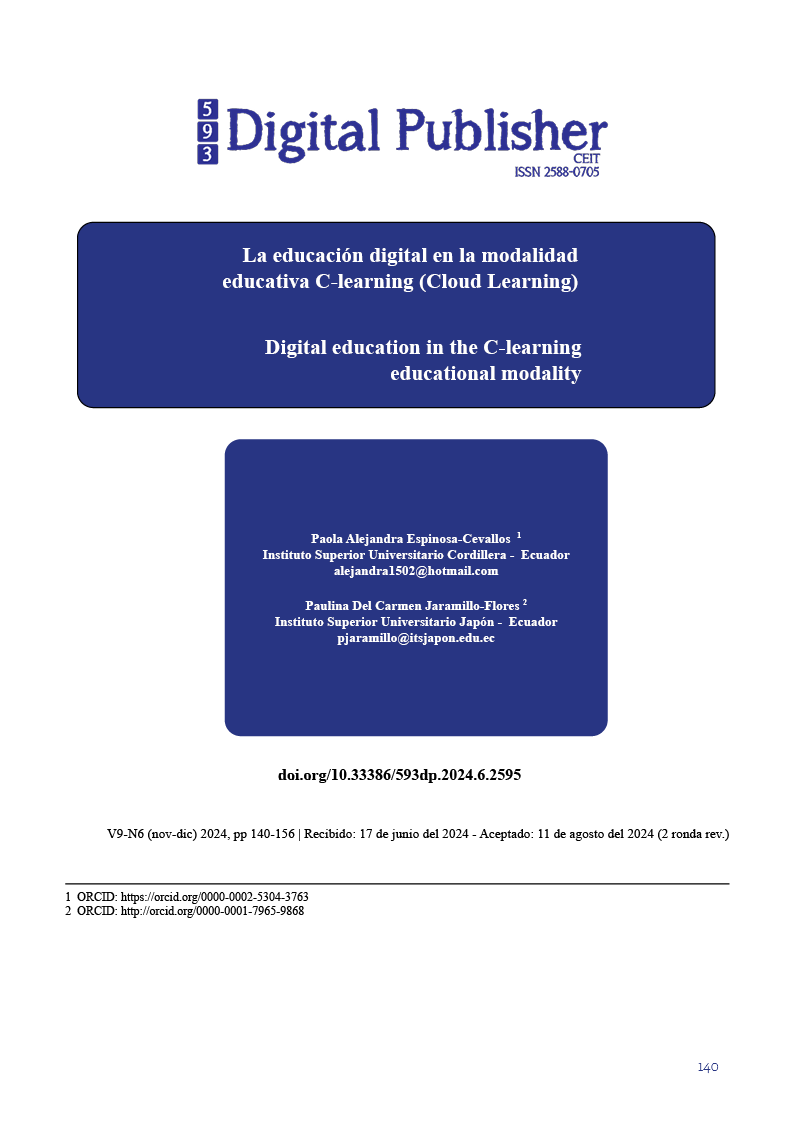Digital education in the C-learning educational modality
Main Article Content
Abstract
Digital education and cloud learning (C-learning) are transforming the current educational landscape. This systematic literature review examines the concept of C-learning and its applications in digital education. The overall objective was to review cloud learning and its uses in digital education. An exhaustive search was carried out in databases such as ACM Digital Library, IEEE eXplorer, Science Direct Elsevier, Scopus, Google Scholar and Springer Link, identifying 43 documents, of which 21 were selected that met the established criteria. C-learning is based on cloud computing and emphasizes student-centered resource sharing and collaboration to create personalized learning environments. The main trends identified include student-centered learning, customization of learning, reduction of cognitive load through cloud storage, new models of organizing educational resources, and improved collaboration. It is determined that C-learning offers significant opportunities to improve the quality and accessibility of education, allowing overcoming space and time barriers. However, its effective implementation requires addressing challenges such as equity in access, teacher training and the adaptation of students to this new educational paradigm. Technology in itself does not guarantee better learning, but rather facilitates methodologies and tools that stimulate progress in the educational process in an increasingly multichannel and personalized environment.
Downloads
Article Details

This work is licensed under a Creative Commons Attribution-NonCommercial-ShareAlike 4.0 International License.
1. Derechos de autor
Las obras que se publican en 593 Digital Publisher CEIT están sujetas a los siguientes términos:
1.1. 593 Digital Publisher CEIT, conserva los derechos patrimoniales (copyright) de las obras publicadas, favorece y permite la reutilización de las mismas bajo la licencia Licencia Creative Commons 4.0 de Reconocimiento-NoComercial-CompartirIgual 4.0, por lo cual se pueden copiar, usar, difundir, transmitir y exponer públicamente, siempre que:
1.1.a. Se cite la autoría y fuente original de su publicación (revista, editorial, URL).
1.1.b. No se usen para fines comerciales u onerosos.
1.1.c. Se mencione la existencia y especificaciones de esta licencia de uso.
References
Amazon Web Services. (2023). AWS Educate. Recuperado de https://aws.amazon.com/es/education/awseducate/
Anthology. (2023). Blackboard Learn Ultra case study: Greenville Technical College. Recuperado de https://www.anthology.com/story/upgrading-to-blackboard-learn-ultra-improves-student-satisfaction-success-and-retention
Almusharraf, N., & Khahro, S. (2020). Students' satisfaction with online learning experiences during the COVID-19 pandemic. International Journal of Emerging Technologies in Learning, 15(21), 246-267. Recuperado de https://online-journals.org/index.php/i-jet/article/view/15647
Bai, Y., Shen, S., Chen, L., & Zhuo, Y. (2011). Cloud learning: A new learning style. IEEE Conference on Multimedia Technology. Recuperado de http://ieeexplore.ieee.org/document/6002268/
Consorti, F., Mancuso, R., Nocioni, M., & Piccolo, A. (2012). Efficacy of virtual patients in medical education: A meta-analysis of randomized studies. Computers & Education, 59(3), 1001-1008. Recuperado de https://www.sciencedirect.com/science/article/abs/pii/S0360131512001017
Decuypere, M., Grimaldi, E., & Landri, P. (2021). Introduction: Critical studies of digital education platforms. Critical Studies in Education, 62(1), 1-16. Recuperado de https://www.tandfonline.com/doi/full/10.1080/17508487.2020.1866050
Dijck, J. V., Poell, T., & Waal, M. D. (2018). The platform society: Public values in a connective world. Oxford University Press.
Elzeiny, S., El-Ghareeb, H. A., & Seddiek, N. (2013). Cloud storage: A survey. Semantic Scholar. Recuperado de https://www.semanticscholar.org/paper/Cloud-Storage-%3A-A-Survey-Elzeiny-Elfetouh/e516b5c1cc3c7bfbf30368e82862c5ba79b7fdfe
Google for Education. (2023). Case study: Vicksburg Warren School District. Recuperado de https://edu.google.com/why-google/customer-stories/
Haleem, A., Javaid, M., Qadri, M. A., & Suman, R. (2022). Understanding the role of digital technologies in education: A review. Sustainable Operations and Computers, 3, 275-285. Recuperado de https://linkinghub.elsevier.com/retrieve/pii/S2666412722000137
Hillman, T., Rensfeldt, A. B., & Ivarsson, J. (2020). Brave new platforms: A possible platform future for highly decentralised schooling. Learning, Media and Technology, 45(1), 7-16. Recuperado de https://www.tandfonline.com/doi/full/10.1080/17439884.2020.1683748
IDC. (2023). Future of Intelligence: AI and automation in cloud-based learning environments. [No se encontró URL]
Kitchenham, B. (2004). Procedures for performing systematic reviews. Keele University Technical Report TR/SE-0401. Recuperado de https://eprints.keele.ac.uk/view/year/2022.html
Lewis, S. (2021). The turn towards policy mobilities and the theoretical-methodological implications for policy sociology. Critical Studies in Education, 62(1), 38-54. Recuperado de https://www.tandfonline.com/doi/full/10.1080/17508487.2020.1808499
Lorentzen, A. S., Mørch, A. I., & Ørnes, H. (2022). C-learning en el proceso de enseñanza y aprendizaje. Código Científico Revista de Investigación.
McCall, M., Spencer, E., Owen, H., Roberts, N., & Heneghan, C. (2018). Characteristics and efficacy of digital health education: An overview of systematic reviews. Health Education Journal, 77(5), 497-514. Recuperado de https://journals.sagepub.com/doi/abs/10.1177/0017896918762013
McLaughlin, C. (2018). What is digital education? The University of Edinburgh.
Microsoft. (2023). Case study: University of New South Wales. Recuperado de https://news.microsoft.com/source/features/work-life/high-tech-for-higher-ed-an-australian-engineering-professor-revamps-student-learning-with-teams/
Mitakos, T., Almaliotis, I., & Demerouti, A. (2014). An insight on e-learning and cloud computing systems. Informatica Economica, 18(4), 5-14.
Pireva, K., Imran, A. S., & Dalipi, F. (2014). Cloud e-learning: A new challenge for multi-agent systems. Springer.
Proctorizer. (2024). The future of digital education. Recuperado de https://proctorizer.com/como-impacta-la-ia-generativa-y-chatgpt-en-la-educacion-superior/
Robertson, S. L. (2018). Comparing platforms and the new value economy in the academy. En World Yearbook of Education 2019 (pp. 169-186). Routledge.
Sánchez, M., & Aguilar, J. (2015). Aprendizaje en la nube: Una propuesta para la formación en línea. Revista Iberoamericana de Educación en Tecnología y Tecnología en Educación, 15, 17-28.
Scager, K., Boonstra, J., Peeters, T., Vulperhorst, J., & Wiegant, F. (2016). Collaborative learning in higher education: Evoking positive interdependence. CBE Life Sciences Education, 15(4), ar69.
SMOWL. (2023). Digital education trends.
Sumiharsono, R., Wiyono, B. B., Imron, A., & Arifin, I. (2021). Design considerations for ubiquitous learning environment. Turkish Journal of Computer and Mathematics Education, 12(13), 4405-4413.
UNESCO. (2023). Digital education: Opportunities and challenges. Recuperado de https://www.unesco.org/en/futures-education/digital-learning-futures
Valbuena, S. (2021). Inclusión del C-learning en la enseñanza de los ecosistemas. Universidad Santo Tomás. Recuperado de https://revistas.usantotomas.edu.co/index.php/citas/article/view/6363
Van Harmelen, M. (2008). Design trajectories: Four experiments in PLE implementation. Interactive Learning Environments, 16(1), 35-46.
Williamson, B. (2019). Policy networks, performance metrics and platform markets: Charting the expanding data infrastructure of higher education. British Journal of Educational Technology, 50(6), 2794-2809.
Yu, S., Yang, X., Cheng, G., & Wang, M. (2015). From learning object to learning cell: A resource organization model for ubiquitous learning. Educational Technology & Society, 18(2), 206-224



